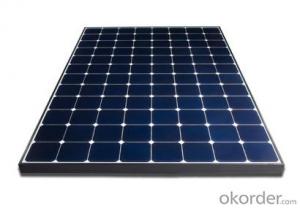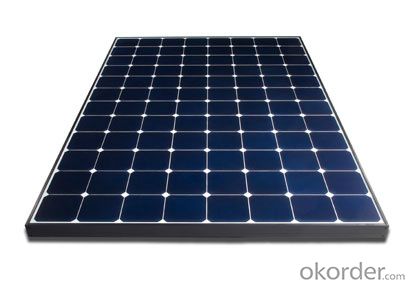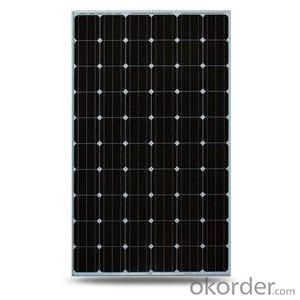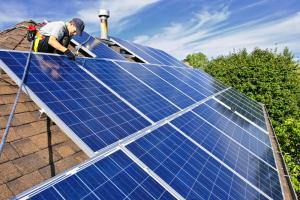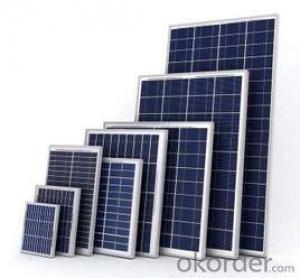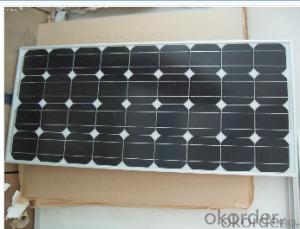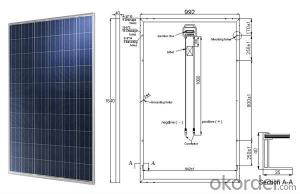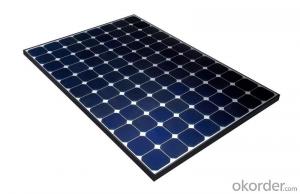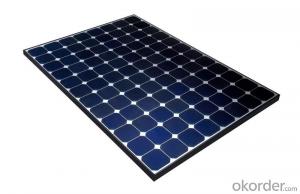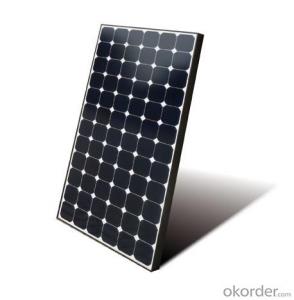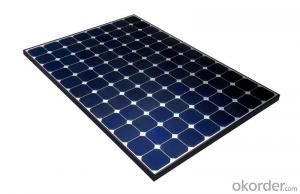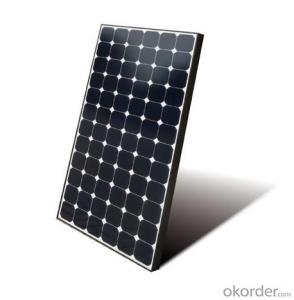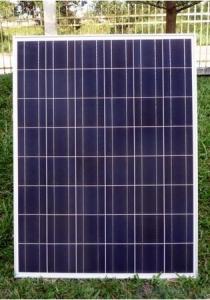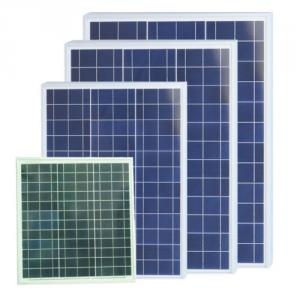Santan Solar Panels - CNBM Poly 195W Solar Panel with TUV UL CE Certificate for Residential
- Loading Port:
- Shanghai
- Payment Terms:
- TT OR LC
- Min Order Qty:
- 100 watt
- Supply Capability:
- 1000 watt/month
OKorder Service Pledge
OKorder Financial Service
You Might Also Like
Specification
CNBM Poly 195W Solar Panel with TUV UL CE Certificate For Residential
Introduction
Electrical connections are made in series to achieve a desired output voltage and/or in parallel to provide a desired current capability. The conducting wires that take the current off the modules may contain silver, copper or other non-magnetic conductive [transition metals]. The cells must be connected electrically to one another and to the rest of the system. Externally, popular terrestrial usage photovoltaic modules use MC3 (older) or MC4 connectors to facilitate easy weatherproof connections to the rest of the system.
Each module is rated by its DC output power under standard test conditions, and typically ranges from 100 to 365 watts. The efficiency of a module determines the area of a module given the same rated output – an 8% efficient 230 watt module will have twice the area of a 16% efficient 230 watt module. There are a few solar panels available that are exceeding 19% efficiency. A single solar module can produce only a limited amount of power; most installations contain multiple modules. A photovoltaic system typically includes a panel or an array of solar modules, a solar inverter, and sometimes a battery and/or solar tracker and interconnection wiring.
Micro-inverted solar panels are wired in parallel which produces more output than normal panels which are wired in series with the output of the series determined by the lowest performing panel (this is known as the "Christmas light effect"). Micro-inverters work independently so each panel contributes its maximum possible output given the available sunlight.[6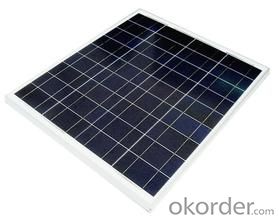
Suggested application
Home lighting business lighting,
Garden lighting, pavement lighting
Farmer household lighting
Decorative water pump
Traffic signal lighting
Industry area
Business area
Solar Power Plant
Product feature
Modules are made of Monocrystalline or Polycrystalline Silicon cell.
Materials and color of the solar panel frame: Clear anodized aluminum alloy type 6063T5 Universal frame; Silver-white color;
The output connection gathers the coupling: Selects conforms to the IEC-612615; 2005, class II, IEC61730 international standard; Airtight waterproofing binding clamp;
Module seal structure: The surface is thick, the high diaphanous rate armored glass with solar cell board special-purpose 3.2mm becomes after the high temperature lamination craft. The back selects has waterproof and anti- aged performance fine TPT materials. The entire block battery board has, the waterproofing, the anti- aging airtight and so on the fine performance;
Power tolerance: +/-3%
Packaging
International standard cartons (according to the requirements of customers)
- Q: discription how does solar panels save energy
- Solar panels don't save energy, they just utilize a different source of energy. To the extent that it replaces energy from sources which are limited themselves (such as fossil fuels), solar energy does save those resources.* The main benefits of solar energy are environmental in the sense that it is nonpolluting,* but using solar energy doesn't reduce actual power consumption. *Excludes environmental costs of producing the solar panels themselves, but these are much smaller than the environmental benefits of solar vs. fossil fuel (which has infrastructure costs of its own).
- Q: I've recently started a project to help my store become more green and I need to get some estimates from businesses and if all goes according to plan we will have some panels on our roof and some other measures that I've written into my proposal. Any help is welcome. Just so you know it's a large grocery store in a corporate chain and I've been approved to do all the research, just no promises of payment.
- Google the following: solar panels oregon. Here are a few from the first site listed below. Sorry for the capitalization; that was the site's formatting choice, not mine. SOLAR INC. 3698 Franklin Blvd Eugene, OR 97403 (54) 284-2426 ADVANCED ENERGY SYSTEMS 2990 FOREST BOULEVARD, EUGENE, OR 97405 Phone: (54) 683-2345 ALTERNATIVE POWER MACHINE 4040 HIGHLAND AVENUE, GRANTS PASS, OR 97526 Phone: (54) 476-896 CASCADE SUN WORKS INCORPORATED 2444 SE FIRST STREET, REDMOND, OR 97756 Phone: (54) 548-7887 ENERGY OUTFITTERS LTD. 543 NE E St Grants Pass, OR 97526 (54) 476-4200 ENVIRONMENTAL BUILDING SUPPLIES 89 SE TAYLOR STREET, PORTLAND, OR 9724 Phone: (503) 222-388 KING SOLAR SERVICES 4435 MAPLETON DRIVE, WEST LINN, OR 97068 Phone: (503) 635-5560 MR SUN SOLAR 3838 SW MACADAM AVENUE, PORTLAND, OR 97239 Phone: (503) 222-2468 OERGON SOLAR WATER TALENT, OR 97540 Phone: (54) 535-7332 PROTECH SOLAR 409 PINE STREET, ORETECH, OR 9760 Phone: (54) 882-4545 SOLAR ASSIST 395 CROSS STREET SUITE 2, EUGENE, OR 97402 Phone: (54) 338-4957 SOLAR COLLECTION INCORPORATED 934 PIONEER ROAD, TALENT, OR 97540 Phone: (54) 535-5364 SOLAR DESIGN CONSTRUCTION 825 SE PARK AVENUE, CORVALLIS, OR 97333 Phone: (54) 753-8725 SOLAR ENERGY SOLUTIONS 3730 SE LAFAYETTE COURT, PORTLAND, OR 97202 Phone: (503) 238-4502 SOLAR WIND POWER OF PORTLAND 0006 SW CANYON ROAD, WEST HAVEN SYLVAN, OR 97225 Phone: (503) 297-578 SUMMERS SOLAR SYSTEMS EUGENE, OR 9740 Phone: (54) 683-404 SUMMERS SOLAR SYSTEMS 7342 RAINBOW DRIVE SE, SALEM, OR 97306 Phone: (503) 363-408 SUNBOW SOLAR 074 NW RACHEL STREET, HILLSBORO, OR 9724 Phone: (503) 640-665 SUNLIGHT SOLAR ENERGY 4 NW FRANKLIN AVENUE, BEND, OR 9770 Phone: (54) 322-90 UNITED SOLAR COMPANY 905 SW BUTLER ROAD, GRESHAM, OR 97080 Phone: (503) 666-3065
- Q: What would these solar panels power? For instance, my energy bill shows 2035kWh for last month. How much would this remove from that if it outputted full power? Thanks!
- For okorder As for that kit you are looking at, that is more suitable for mounting on a travel trailer somewhere where you are camping to recharge the deep cycle battery for the low voltage appliances you are using. Right now is probably a good time to start looking at ways of either running on low voltage, say for general lighting in a basement, or shed, and putting up some means of maintaining those batteries with solar and or wind. If you start small, you can add on at any time.
- Q: Can solar panels be installed in a shaded area?
- Solar panels can still be installed in a shaded area, but their efficiency will be significantly reduced as they rely on direct sunlight to generate electricity.
- Q: What do these mean? I'm interested in doing a solar panel project. The problem is I know nothing about electricity, wiring, or panels so I've bought a small panel to experiment with first.I don't know what amps, watts, or volts are; what I should be reading on the batteries I will be charging? Or on the small appliances I will be running?The panel I bought has four settings:. 3V ---- 200mA2. 6V ---- 00 mA3. 9V ---- 50mA4. 2V ---- 50 mA(What is mA?)Also, will you give examples of what I can run with this? Make up any scenarios with whatever amps/volts/watts.
- . 3V 200mA. mA (milliAmp) = 0.00A; Power = 3V x 0.2A = 0.6 Watts. 2. 6V 00mA is 6 x 0. = 0.6 Watts. 3. 9V 50mA is 9 x 0.05 = 0.45 Watts. 4. 2V 50mA is 2 x 0.05 = 0.6 Watts. With the 3 Volts one you could connect it to a flashlight light bulb, that's is about the max you can get out of it. With the light bulb, polarity doesn't matter, but if you power a small transistor radio with it, then make sure the + goes to the + and the - to the -. Reversing it wouldn't work and in some cases you could damage equipment.
- Q: im trying to run my house with with solar panels, is it possible? if so please let me know how....i have a 6000 w inverter
- No, okorder /
- Q: I need to know what the main components of a solar water heater and how they functionThanks if you answer x
- For vacuum tubes solar heaters the main component include: solar tank, vacuum tubes, solar frames, and the pipelines and fittings of whole system
- Q: How do I clean my solar panels?
- To clean your solar panels, you can start by rinsing them with a garden hose to remove any loose dirt or debris. If there are tougher stains or bird droppings, use a soft sponge or cloth with mild soapy water to gently scrub the surface. Avoid using abrasive materials or harsh chemicals that could damage the panels. Additionally, make sure to turn off the system and use caution when climbing on the roof. Regular cleaning every few months can help maintain optimal performance of your solar panels.
- Q: Can I add reflectors or mirrors around the solar panels to increase the power they generate?
- In the 70's when silicon was really expensive, they played with using fresnel lenses to focus the sunlight on small solar cells but these panels had to be on heliostats and aimed directly at the Sun. These days, with nano-technology, there's a renewed interest in the concept but the fundamental weakness is that there are diminishing returns, at some point, it's just less expensive to have more solar cells.
- Q: Could you throw some long scientific words in with your answer so I can impress my teacher, I'm looking to expand my scientific vocab. Thanks
- Actually Photovoltaic cells also called solar cells in collection forms solar panel. Photovoltaic cells consist of silicon for converting solar energy into electrical energy.
Send your message to us
Santan Solar Panels - CNBM Poly 195W Solar Panel with TUV UL CE Certificate for Residential
- Loading Port:
- Shanghai
- Payment Terms:
- TT OR LC
- Min Order Qty:
- 100 watt
- Supply Capability:
- 1000 watt/month
OKorder Service Pledge
OKorder Financial Service
Similar products
Hot products
Hot Searches
Related keywords
